PMMP 20008: Project Plan for NAIDOC Week Event at CQU
VerifiedAdded on 2022/09/06
|29
|3920
|20
Project
AI Summary
This document presents a project plan for organizing NAIDOC Week events at CQUniversity, as part of the PMMP 20008 course. The plan details the project description, background, and major deliverables, emphasizing cultural awareness and engagement with Aboriginal and Torres Strait Islander peoples. It includes a stakeholder analysis, assessing engagement levels and outlining communication methods. The requirements management section addresses traditional custodians, opening statements, and requirements gathering. The project scope, schedule, cost baseline, risk assessment, and tolerances are also discussed. The project aims to increase awareness of indigenous perspectives and cultures through simultaneous events on multiple campuses, fostering collaboration with local Aboriginal communities and aligning with the NAIDOC theme. The plan addresses various aspects of event planning including venue, logistics, budget, and management of the event and its stakeholders.
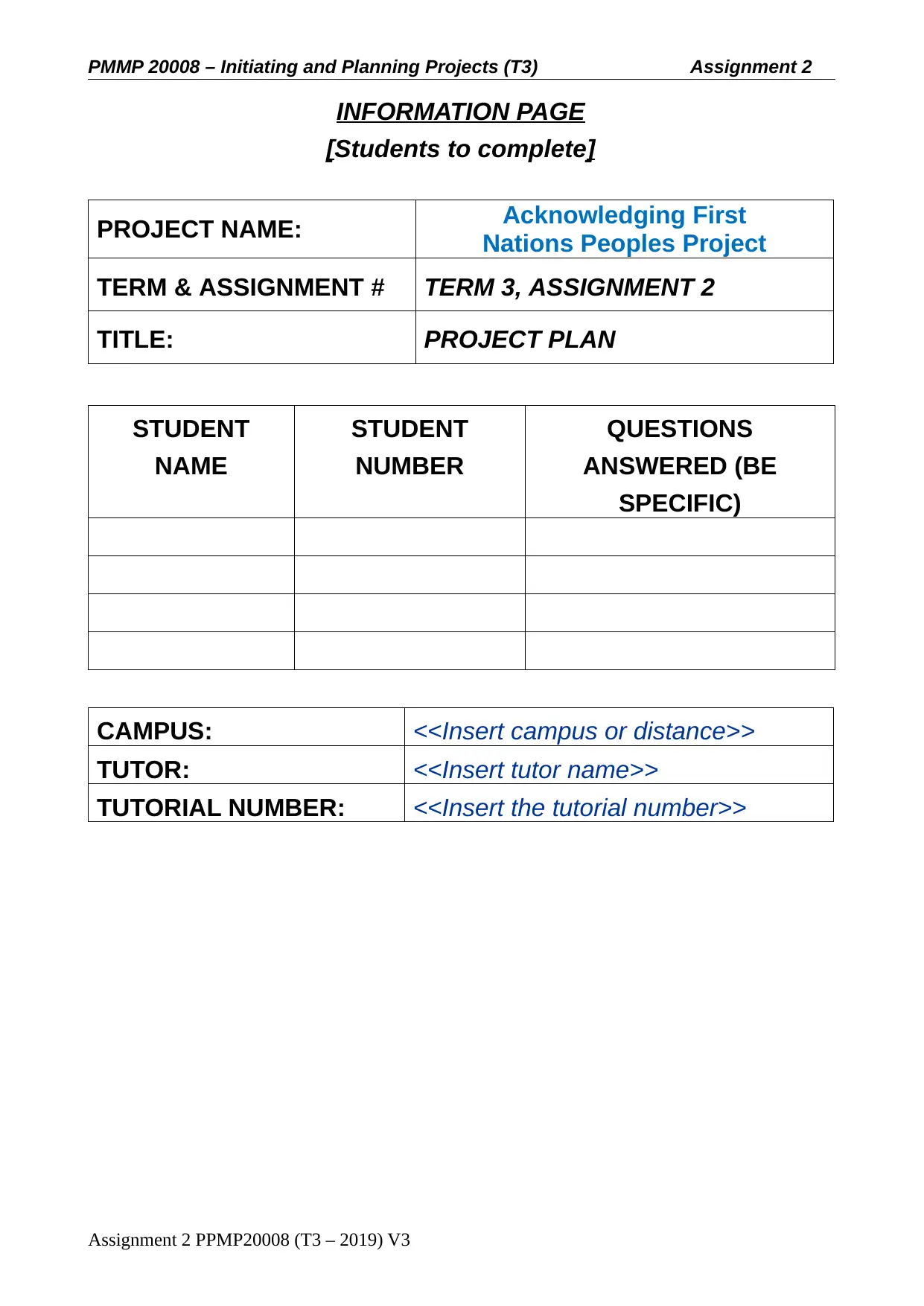
PMMP 20008 – Initiating and Planning Projects (T3) Assignment 2
INFORMATION PAGE
[Students to complete]
PROJECT NAME: Acknowledging First
Nations Peoples Project
TERM & ASSIGNMENT # TERM 3, ASSIGNMENT 2
TITLE: PROJECT PLAN
STUDENT
NAME
STUDENT
NUMBER
QUESTIONS
ANSWERED (BE
SPECIFIC)
CAMPUS: <<Insert campus or distance>>
TUTOR: <<Insert tutor name>>
TUTORIAL NUMBER: <<Insert the tutorial number>>
Assignment 2 PPMP20008 (T3 – 2019) V3
INFORMATION PAGE
[Students to complete]
PROJECT NAME: Acknowledging First
Nations Peoples Project
TERM & ASSIGNMENT # TERM 3, ASSIGNMENT 2
TITLE: PROJECT PLAN
STUDENT
NAME
STUDENT
NUMBER
QUESTIONS
ANSWERED (BE
SPECIFIC)
CAMPUS: <<Insert campus or distance>>
TUTOR: <<Insert tutor name>>
TUTORIAL NUMBER: <<Insert the tutorial number>>
Assignment 2 PPMP20008 (T3 – 2019) V3
Paraphrase This Document
Need a fresh take? Get an instant paraphrase of this document with our AI Paraphraser
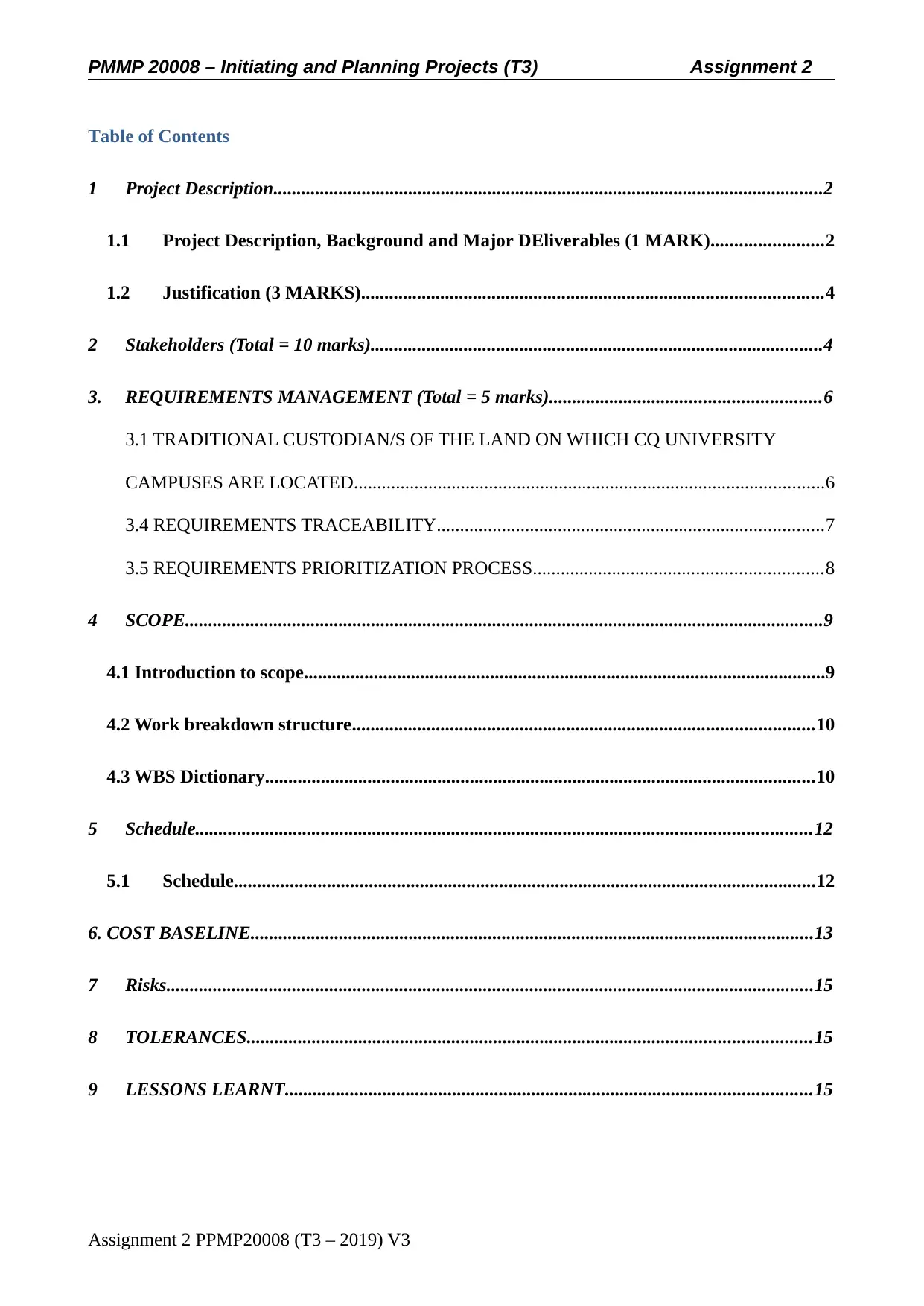
PMMP 20008 – Initiating and Planning Projects (T3) Assignment 2
Table of Contents
1 Project Description......................................................................................................................2
1.1 Project Description, Background and Major DEliverables (1 MARK)........................2
1.2 Justification (3 MARKS)...................................................................................................4
2 Stakeholders (Total = 10 marks).................................................................................................4
3. REQUIREMENTS MANAGEMENT (Total = 5 marks)..........................................................6
3.1 TRADITIONAL CUSTODIAN/S OF THE LAND ON WHICH CQ UNIVERSITY
CAMPUSES ARE LOCATED.....................................................................................................6
3.4 REQUIREMENTS TRACEABILITY...................................................................................7
3.5 REQUIREMENTS PRIORITIZATION PROCESS..............................................................8
4 SCOPE.........................................................................................................................................9
4.1 Introduction to scope................................................................................................................9
4.2 Work breakdown structure...................................................................................................10
4.3 WBS Dictionary......................................................................................................................10
5 Schedule....................................................................................................................................12
5.1 Schedule.............................................................................................................................12
6. COST BASELINE.........................................................................................................................13
7 Risks...........................................................................................................................................15
8 TOLERANCES.........................................................................................................................15
9 LESSONS LEARNT.................................................................................................................15
Assignment 2 PPMP20008 (T3 – 2019) V3
Table of Contents
1 Project Description......................................................................................................................2
1.1 Project Description, Background and Major DEliverables (1 MARK)........................2
1.2 Justification (3 MARKS)...................................................................................................4
2 Stakeholders (Total = 10 marks).................................................................................................4
3. REQUIREMENTS MANAGEMENT (Total = 5 marks)..........................................................6
3.1 TRADITIONAL CUSTODIAN/S OF THE LAND ON WHICH CQ UNIVERSITY
CAMPUSES ARE LOCATED.....................................................................................................6
3.4 REQUIREMENTS TRACEABILITY...................................................................................7
3.5 REQUIREMENTS PRIORITIZATION PROCESS..............................................................8
4 SCOPE.........................................................................................................................................9
4.1 Introduction to scope................................................................................................................9
4.2 Work breakdown structure...................................................................................................10
4.3 WBS Dictionary......................................................................................................................10
5 Schedule....................................................................................................................................12
5.1 Schedule.............................................................................................................................12
6. COST BASELINE.........................................................................................................................13
7 Risks...........................................................................................................................................15
8 TOLERANCES.........................................................................................................................15
9 LESSONS LEARNT.................................................................................................................15
Assignment 2 PPMP20008 (T3 – 2019) V3
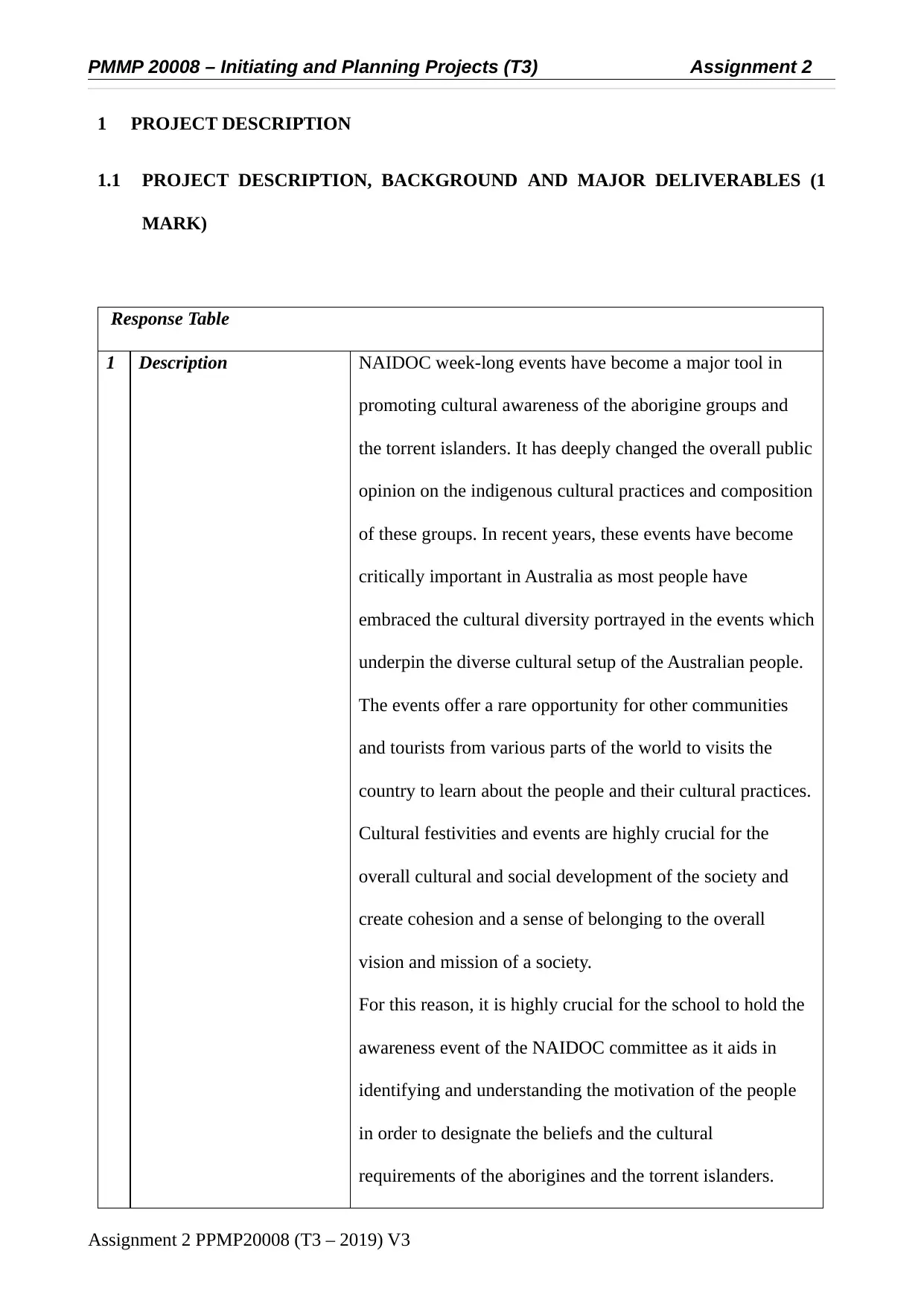
PMMP 20008 – Initiating and Planning Projects (T3) Assignment 2
1 PROJECT DESCRIPTION
1.1 PROJECT DESCRIPTION, BACKGROUND AND MAJOR DELIVERABLES (1
MARK)
Response Table
1 Description NAIDOC week-long events have become a major tool in
promoting cultural awareness of the aborigine groups and
the torrent islanders. It has deeply changed the overall public
opinion on the indigenous cultural practices and composition
of these groups. In recent years, these events have become
critically important in Australia as most people have
embraced the cultural diversity portrayed in the events which
underpin the diverse cultural setup of the Australian people.
The events offer a rare opportunity for other communities
and tourists from various parts of the world to visits the
country to learn about the people and their cultural practices.
Cultural festivities and events are highly crucial for the
overall cultural and social development of the society and
create cohesion and a sense of belonging to the overall
vision and mission of a society.
For this reason, it is highly crucial for the school to hold the
awareness event of the NAIDOC committee as it aids in
identifying and understanding the motivation of the people
in order to designate the beliefs and the cultural
requirements of the aborigines and the torrent islanders.
Assignment 2 PPMP20008 (T3 – 2019) V3
1 PROJECT DESCRIPTION
1.1 PROJECT DESCRIPTION, BACKGROUND AND MAJOR DELIVERABLES (1
MARK)
Response Table
1 Description NAIDOC week-long events have become a major tool in
promoting cultural awareness of the aborigine groups and
the torrent islanders. It has deeply changed the overall public
opinion on the indigenous cultural practices and composition
of these groups. In recent years, these events have become
critically important in Australia as most people have
embraced the cultural diversity portrayed in the events which
underpin the diverse cultural setup of the Australian people.
The events offer a rare opportunity for other communities
and tourists from various parts of the world to visits the
country to learn about the people and their cultural practices.
Cultural festivities and events are highly crucial for the
overall cultural and social development of the society and
create cohesion and a sense of belonging to the overall
vision and mission of a society.
For this reason, it is highly crucial for the school to hold the
awareness event of the NAIDOC committee as it aids in
identifying and understanding the motivation of the people
in order to designate the beliefs and the cultural
requirements of the aborigines and the torrent islanders.
Assignment 2 PPMP20008 (T3 – 2019) V3
⊘ This is a preview!⊘
Do you want full access?
Subscribe today to unlock all pages.

Trusted by 1+ million students worldwide
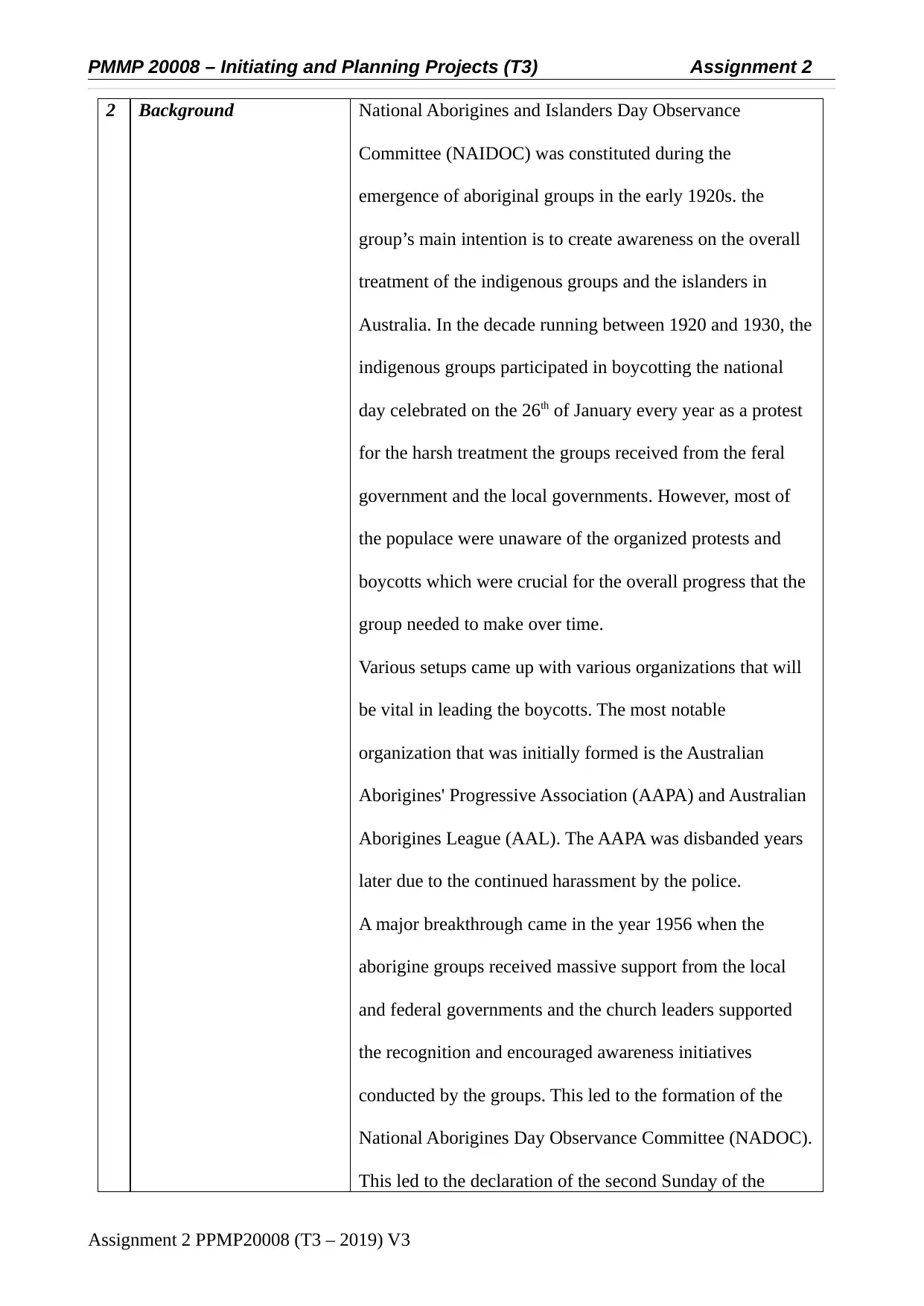
PMMP 20008 – Initiating and Planning Projects (T3) Assignment 2
2 Background National Aborigines and Islanders Day Observance
Committee (NAIDOC) was constituted during the
emergence of aboriginal groups in the early 1920s. the
group’s main intention is to create awareness on the overall
treatment of the indigenous groups and the islanders in
Australia. In the decade running between 1920 and 1930, the
indigenous groups participated in boycotting the national
day celebrated on the 26th of January every year as a protest
for the harsh treatment the groups received from the feral
government and the local governments. However, most of
the populace were unaware of the organized protests and
boycotts which were crucial for the overall progress that the
group needed to make over time.
Various setups came up with various organizations that will
be vital in leading the boycotts. The most notable
organization that was initially formed is the Australian
Aborigines' Progressive Association (AAPA) and Australian
Aborigines League (AAL). The AAPA was disbanded years
later due to the continued harassment by the police.
A major breakthrough came in the year 1956 when the
aborigine groups received massive support from the local
and federal governments and the church leaders supported
the recognition and encouraged awareness initiatives
conducted by the groups. This led to the formation of the
National Aborigines Day Observance Committee (NADOC).
This led to the declaration of the second Sunday of the
Assignment 2 PPMP20008 (T3 – 2019) V3
2 Background National Aborigines and Islanders Day Observance
Committee (NAIDOC) was constituted during the
emergence of aboriginal groups in the early 1920s. the
group’s main intention is to create awareness on the overall
treatment of the indigenous groups and the islanders in
Australia. In the decade running between 1920 and 1930, the
indigenous groups participated in boycotting the national
day celebrated on the 26th of January every year as a protest
for the harsh treatment the groups received from the feral
government and the local governments. However, most of
the populace were unaware of the organized protests and
boycotts which were crucial for the overall progress that the
group needed to make over time.
Various setups came up with various organizations that will
be vital in leading the boycotts. The most notable
organization that was initially formed is the Australian
Aborigines' Progressive Association (AAPA) and Australian
Aborigines League (AAL). The AAPA was disbanded years
later due to the continued harassment by the police.
A major breakthrough came in the year 1956 when the
aborigine groups received massive support from the local
and federal governments and the church leaders supported
the recognition and encouraged awareness initiatives
conducted by the groups. This led to the formation of the
National Aborigines Day Observance Committee (NADOC).
This led to the declaration of the second Sunday of the
Assignment 2 PPMP20008 (T3 – 2019) V3
Paraphrase This Document
Need a fresh take? Get an instant paraphrase of this document with our AI Paraphraser
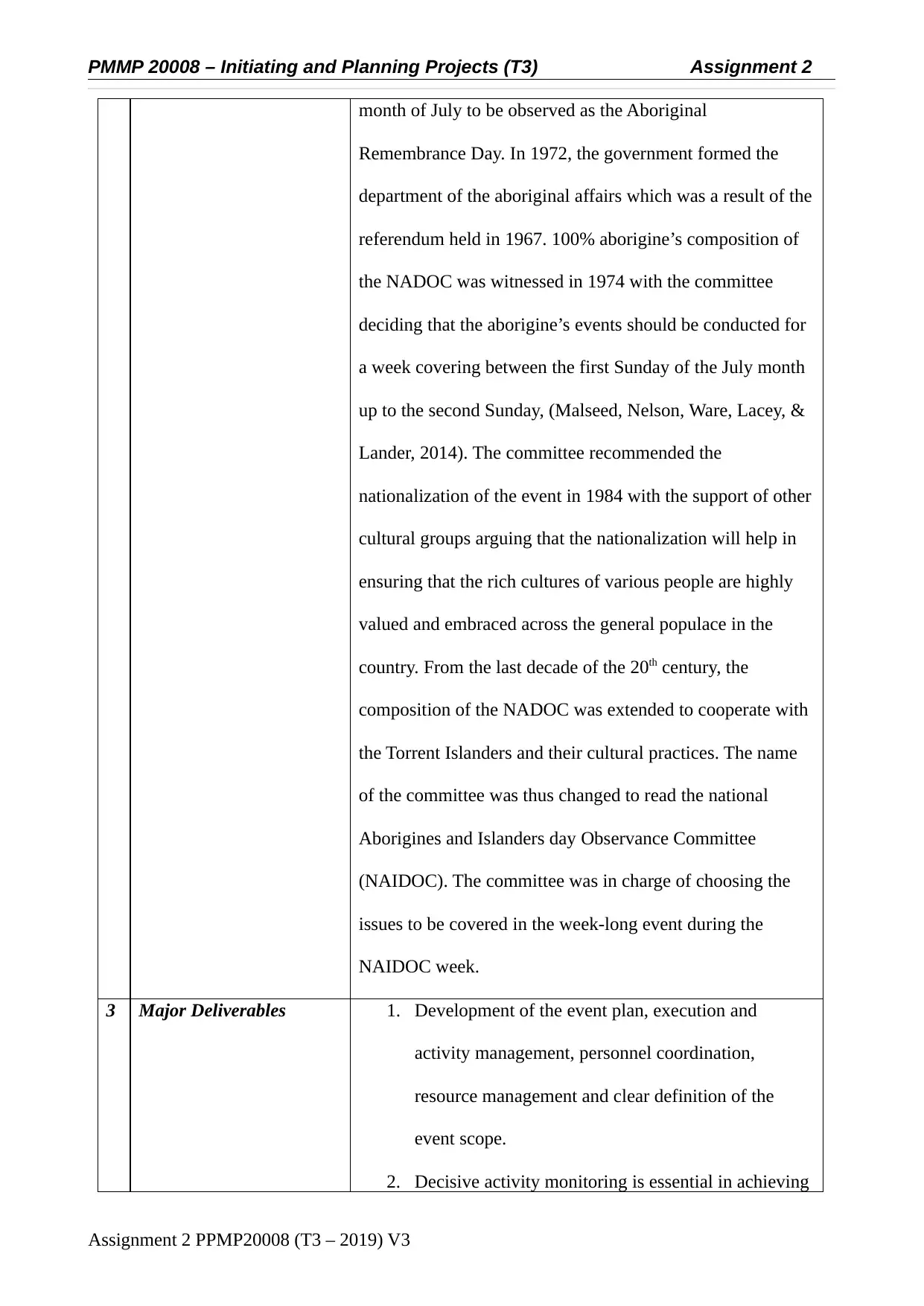
PMMP 20008 – Initiating and Planning Projects (T3) Assignment 2
month of July to be observed as the Aboriginal
Remembrance Day. In 1972, the government formed the
department of the aboriginal affairs which was a result of the
referendum held in 1967. 100% aborigine’s composition of
the NADOC was witnessed in 1974 with the committee
deciding that the aborigine’s events should be conducted for
a week covering between the first Sunday of the July month
up to the second Sunday, (Malseed, Nelson, Ware, Lacey, &
Lander, 2014). The committee recommended the
nationalization of the event in 1984 with the support of other
cultural groups arguing that the nationalization will help in
ensuring that the rich cultures of various people are highly
valued and embraced across the general populace in the
country. From the last decade of the 20th century, the
composition of the NADOC was extended to cooperate with
the Torrent Islanders and their cultural practices. The name
of the committee was thus changed to read the national
Aborigines and Islanders day Observance Committee
(NAIDOC). The committee was in charge of choosing the
issues to be covered in the week-long event during the
NAIDOC week.
3 Major Deliverables 1. Development of the event plan, execution and
activity management, personnel coordination,
resource management and clear definition of the
event scope.
2. Decisive activity monitoring is essential in achieving
Assignment 2 PPMP20008 (T3 – 2019) V3
month of July to be observed as the Aboriginal
Remembrance Day. In 1972, the government formed the
department of the aboriginal affairs which was a result of the
referendum held in 1967. 100% aborigine’s composition of
the NADOC was witnessed in 1974 with the committee
deciding that the aborigine’s events should be conducted for
a week covering between the first Sunday of the July month
up to the second Sunday, (Malseed, Nelson, Ware, Lacey, &
Lander, 2014). The committee recommended the
nationalization of the event in 1984 with the support of other
cultural groups arguing that the nationalization will help in
ensuring that the rich cultures of various people are highly
valued and embraced across the general populace in the
country. From the last decade of the 20th century, the
composition of the NADOC was extended to cooperate with
the Torrent Islanders and their cultural practices. The name
of the committee was thus changed to read the national
Aborigines and Islanders day Observance Committee
(NAIDOC). The committee was in charge of choosing the
issues to be covered in the week-long event during the
NAIDOC week.
3 Major Deliverables 1. Development of the event plan, execution and
activity management, personnel coordination,
resource management and clear definition of the
event scope.
2. Decisive activity monitoring is essential in achieving
Assignment 2 PPMP20008 (T3 – 2019) V3
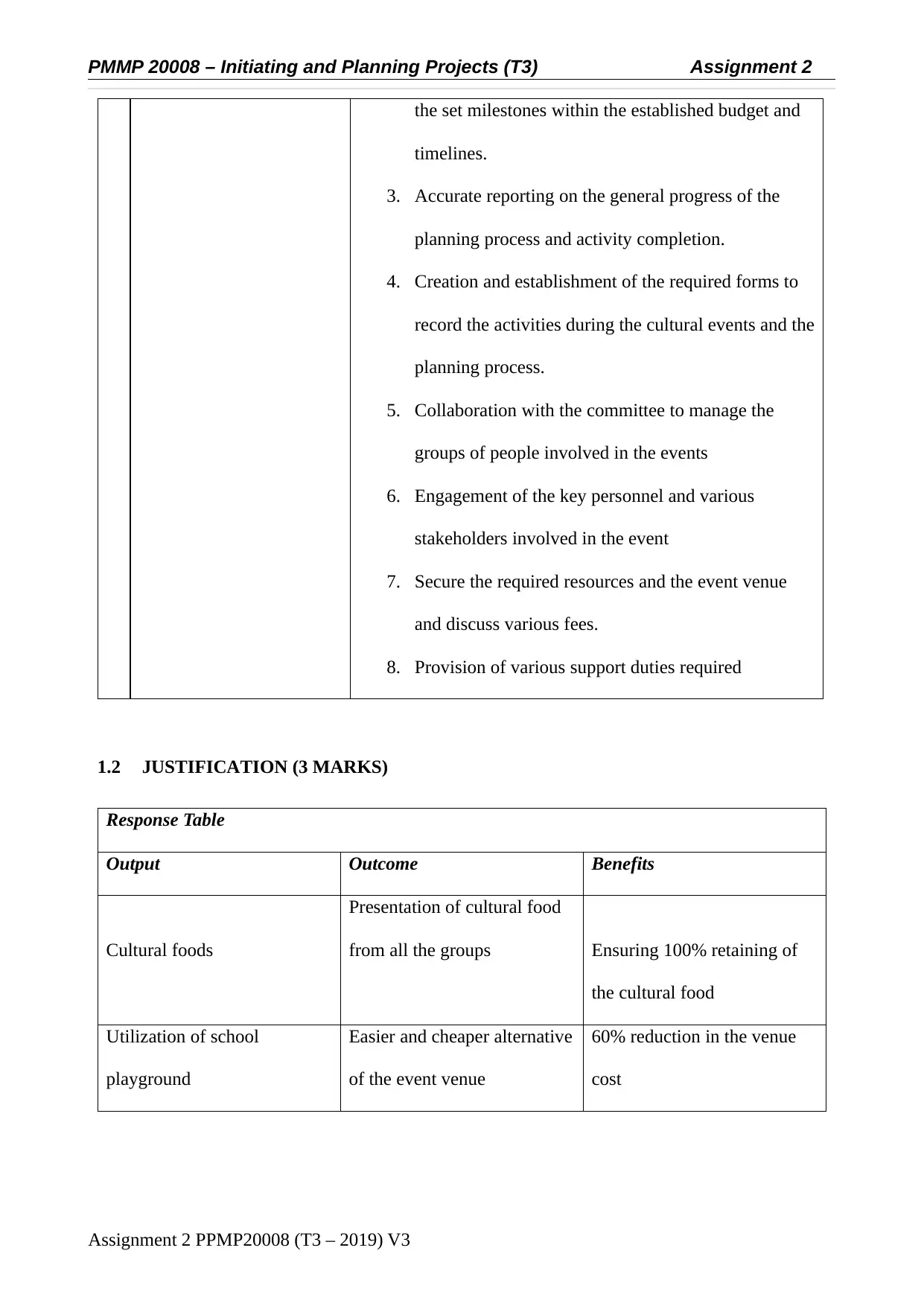
PMMP 20008 – Initiating and Planning Projects (T3) Assignment 2
the set milestones within the established budget and
timelines.
3. Accurate reporting on the general progress of the
planning process and activity completion.
4. Creation and establishment of the required forms to
record the activities during the cultural events and the
planning process.
5. Collaboration with the committee to manage the
groups of people involved in the events
6. Engagement of the key personnel and various
stakeholders involved in the event
7. Secure the required resources and the event venue
and discuss various fees.
8. Provision of various support duties required
1.2 JUSTIFICATION (3 MARKS)
Response Table
Output Outcome Benefits
Cultural foods
Presentation of cultural food
from all the groups Ensuring 100% retaining of
the cultural food
Utilization of school
playground
Easier and cheaper alternative
of the event venue
60% reduction in the venue
cost
Assignment 2 PPMP20008 (T3 – 2019) V3
the set milestones within the established budget and
timelines.
3. Accurate reporting on the general progress of the
planning process and activity completion.
4. Creation and establishment of the required forms to
record the activities during the cultural events and the
planning process.
5. Collaboration with the committee to manage the
groups of people involved in the events
6. Engagement of the key personnel and various
stakeholders involved in the event
7. Secure the required resources and the event venue
and discuss various fees.
8. Provision of various support duties required
1.2 JUSTIFICATION (3 MARKS)
Response Table
Output Outcome Benefits
Cultural foods
Presentation of cultural food
from all the groups Ensuring 100% retaining of
the cultural food
Utilization of school
playground
Easier and cheaper alternative
of the event venue
60% reduction in the venue
cost
Assignment 2 PPMP20008 (T3 – 2019) V3
⊘ This is a preview!⊘
Do you want full access?
Subscribe today to unlock all pages.

Trusted by 1+ million students worldwide
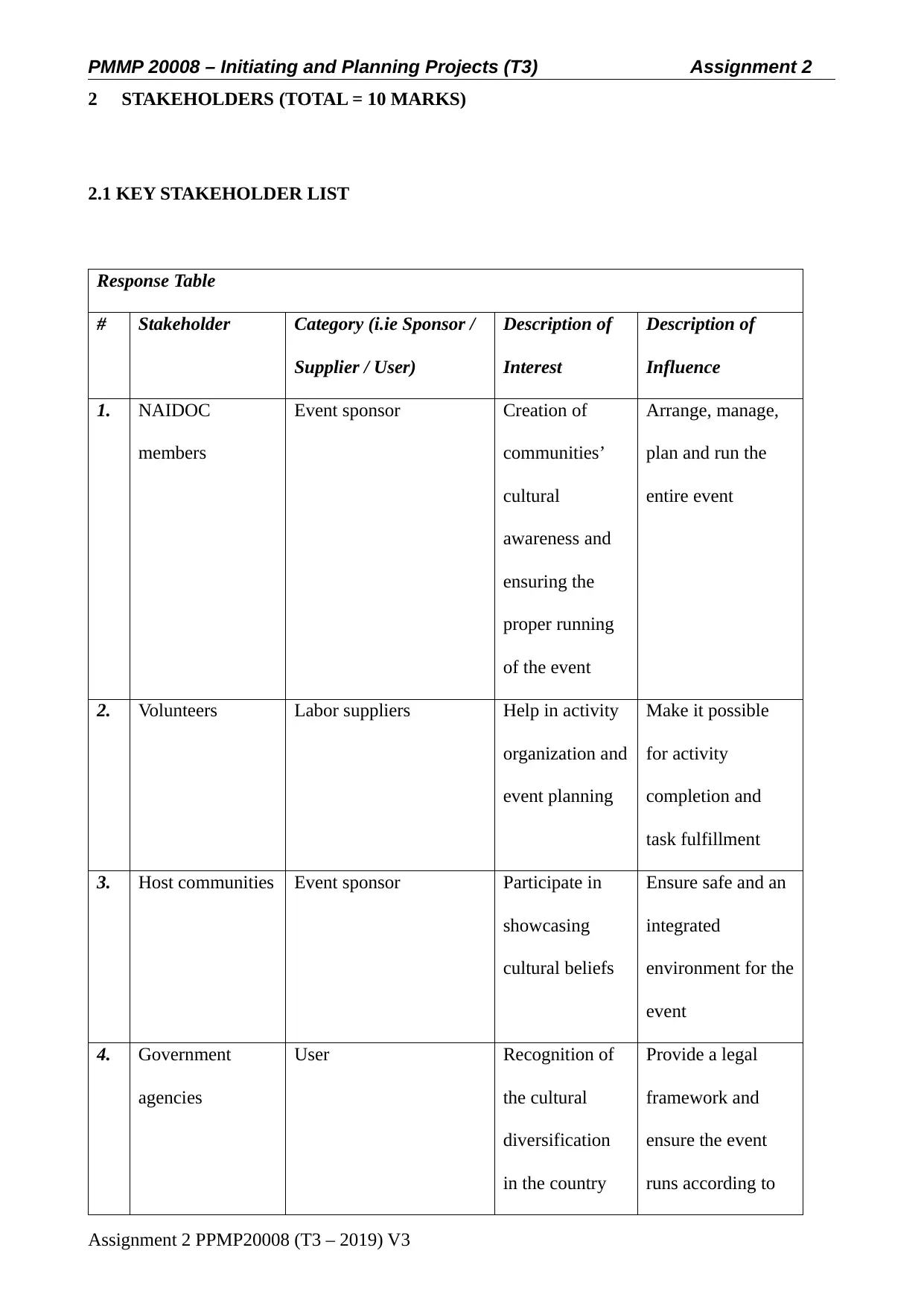
PMMP 20008 – Initiating and Planning Projects (T3) Assignment 2
2 STAKEHOLDERS (TOTAL = 10 MARKS)
2.1 KEY STAKEHOLDER LIST
Response Table
# Stakeholder Category (i.ie Sponsor /
Supplier / User)
Description of
Interest
Description of
Influence
1. NAIDOC
members
Event sponsor Creation of
communities’
cultural
awareness and
ensuring the
proper running
of the event
Arrange, manage,
plan and run the
entire event
2. Volunteers Labor suppliers Help in activity
organization and
event planning
Make it possible
for activity
completion and
task fulfillment
3. Host communities Event sponsor Participate in
showcasing
cultural beliefs
Ensure safe and an
integrated
environment for the
event
4. Government
agencies
User Recognition of
the cultural
diversification
in the country
Provide a legal
framework and
ensure the event
runs according to
Assignment 2 PPMP20008 (T3 – 2019) V3
2 STAKEHOLDERS (TOTAL = 10 MARKS)
2.1 KEY STAKEHOLDER LIST
Response Table
# Stakeholder Category (i.ie Sponsor /
Supplier / User)
Description of
Interest
Description of
Influence
1. NAIDOC
members
Event sponsor Creation of
communities’
cultural
awareness and
ensuring the
proper running
of the event
Arrange, manage,
plan and run the
entire event
2. Volunteers Labor suppliers Help in activity
organization and
event planning
Make it possible
for activity
completion and
task fulfillment
3. Host communities Event sponsor Participate in
showcasing
cultural beliefs
Ensure safe and an
integrated
environment for the
event
4. Government
agencies
User Recognition of
the cultural
diversification
in the country
Provide a legal
framework and
ensure the event
runs according to
Assignment 2 PPMP20008 (T3 – 2019) V3
Paraphrase This Document
Need a fresh take? Get an instant paraphrase of this document with our AI Paraphraser
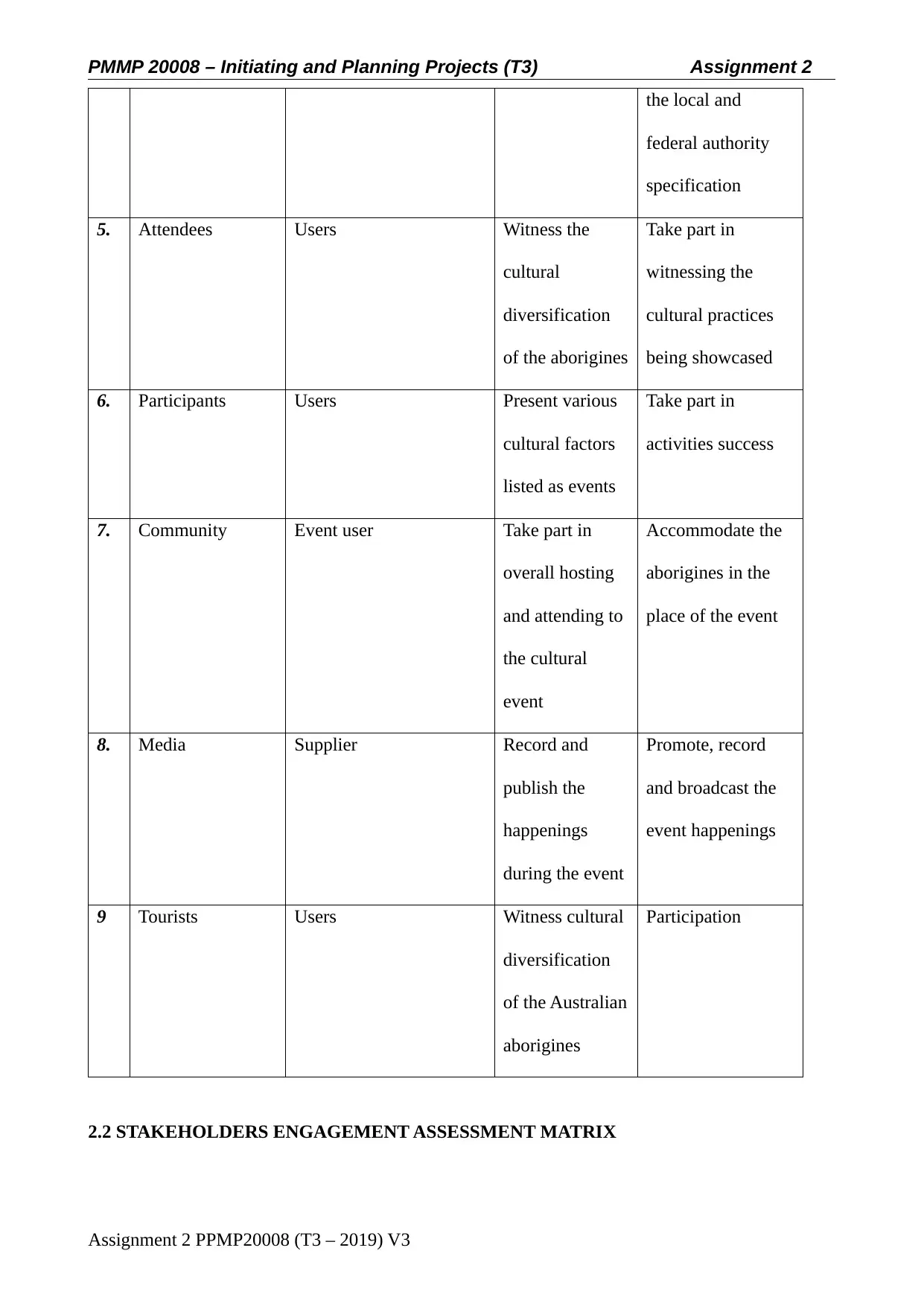
PMMP 20008 – Initiating and Planning Projects (T3) Assignment 2
the local and
federal authority
specification
5. Attendees Users Witness the
cultural
diversification
of the aborigines
Take part in
witnessing the
cultural practices
being showcased
6. Participants Users Present various
cultural factors
listed as events
Take part in
activities success
7. Community Event user Take part in
overall hosting
and attending to
the cultural
event
Accommodate the
aborigines in the
place of the event
8. Media Supplier Record and
publish the
happenings
during the event
Promote, record
and broadcast the
event happenings
9 Tourists Users Witness cultural
diversification
of the Australian
aborigines
Participation
2.2 STAKEHOLDERS ENGAGEMENT ASSESSMENT MATRIX
Assignment 2 PPMP20008 (T3 – 2019) V3
the local and
federal authority
specification
5. Attendees Users Witness the
cultural
diversification
of the aborigines
Take part in
witnessing the
cultural practices
being showcased
6. Participants Users Present various
cultural factors
listed as events
Take part in
activities success
7. Community Event user Take part in
overall hosting
and attending to
the cultural
event
Accommodate the
aborigines in the
place of the event
8. Media Supplier Record and
publish the
happenings
during the event
Promote, record
and broadcast the
event happenings
9 Tourists Users Witness cultural
diversification
of the Australian
aborigines
Participation
2.2 STAKEHOLDERS ENGAGEMENT ASSESSMENT MATRIX
Assignment 2 PPMP20008 (T3 – 2019) V3
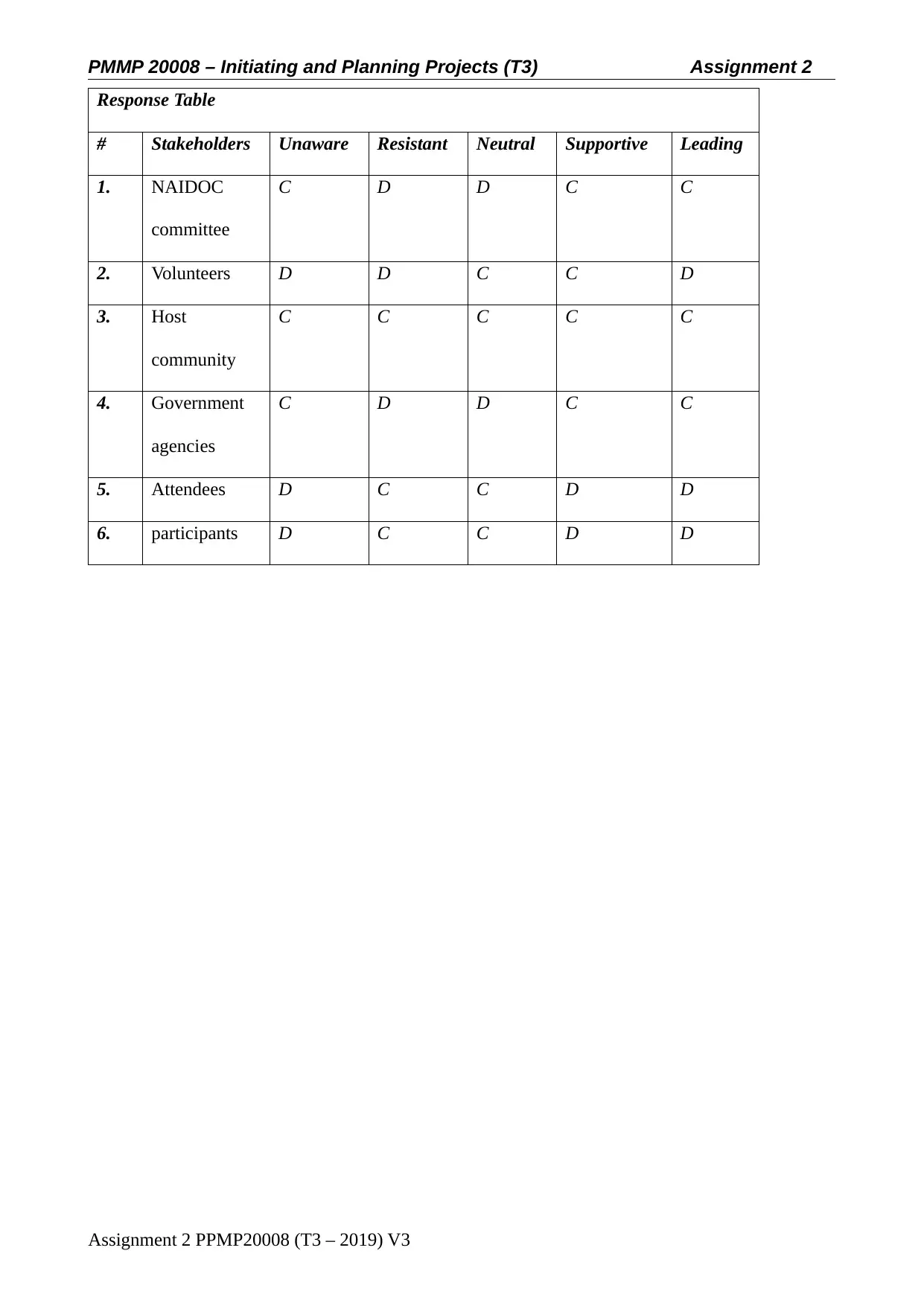
PMMP 20008 – Initiating and Planning Projects (T3) Assignment 2
Response Table
# Stakeholders Unaware Resistant Neutral Supportive Leading
1. NAIDOC
committee
C D D C C
2. Volunteers D D C C D
3. Host
community
C C C C C
4. Government
agencies
C D D C C
5. Attendees D C C D D
6. participants D C C D D
Assignment 2 PPMP20008 (T3 – 2019) V3
Response Table
# Stakeholders Unaware Resistant Neutral Supportive Leading
1. NAIDOC
committee
C D D C C
2. Volunteers D D C C D
3. Host
community
C C C C C
4. Government
agencies
C D D C C
5. Attendees D C C D D
6. participants D C C D D
Assignment 2 PPMP20008 (T3 – 2019) V3
⊘ This is a preview!⊘
Do you want full access?
Subscribe today to unlock all pages.

Trusted by 1+ million students worldwide
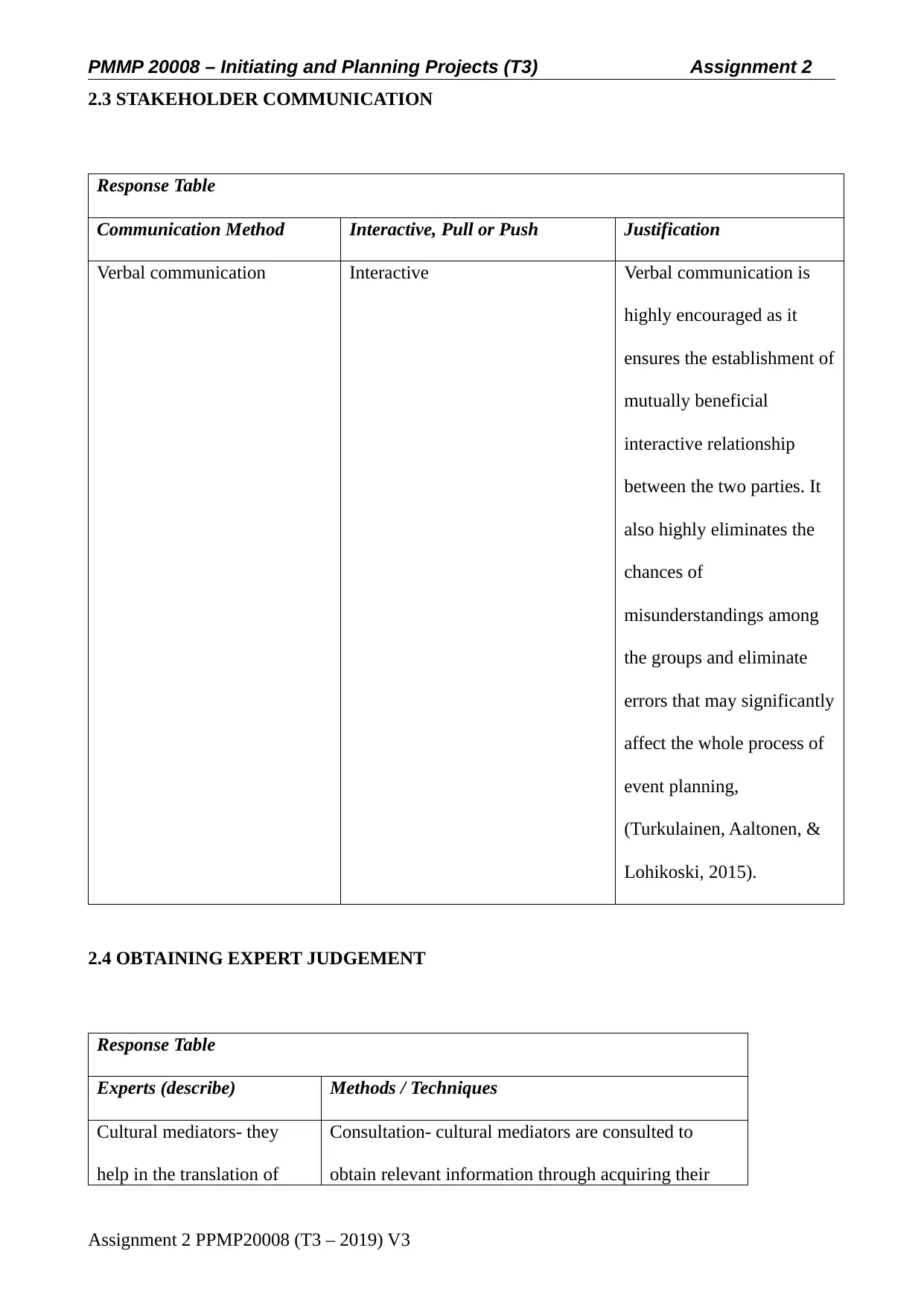
PMMP 20008 – Initiating and Planning Projects (T3) Assignment 2
2.3 STAKEHOLDER COMMUNICATION
Response Table
Communication Method Interactive, Pull or Push Justification
Verbal communication Interactive Verbal communication is
highly encouraged as it
ensures the establishment of
mutually beneficial
interactive relationship
between the two parties. It
also highly eliminates the
chances of
misunderstandings among
the groups and eliminate
errors that may significantly
affect the whole process of
event planning,
(Turkulainen, Aaltonen, &
Lohikoski, 2015).
2.4 OBTAINING EXPERT JUDGEMENT
Response Table
Experts (describe) Methods / Techniques
Cultural mediators- they
help in the translation of
Consultation- cultural mediators are consulted to
obtain relevant information through acquiring their
Assignment 2 PPMP20008 (T3 – 2019) V3
2.3 STAKEHOLDER COMMUNICATION
Response Table
Communication Method Interactive, Pull or Push Justification
Verbal communication Interactive Verbal communication is
highly encouraged as it
ensures the establishment of
mutually beneficial
interactive relationship
between the two parties. It
also highly eliminates the
chances of
misunderstandings among
the groups and eliminate
errors that may significantly
affect the whole process of
event planning,
(Turkulainen, Aaltonen, &
Lohikoski, 2015).
2.4 OBTAINING EXPERT JUDGEMENT
Response Table
Experts (describe) Methods / Techniques
Cultural mediators- they
help in the translation of
Consultation- cultural mediators are consulted to
obtain relevant information through acquiring their
Assignment 2 PPMP20008 (T3 – 2019) V3
Paraphrase This Document
Need a fresh take? Get an instant paraphrase of this document with our AI Paraphraser
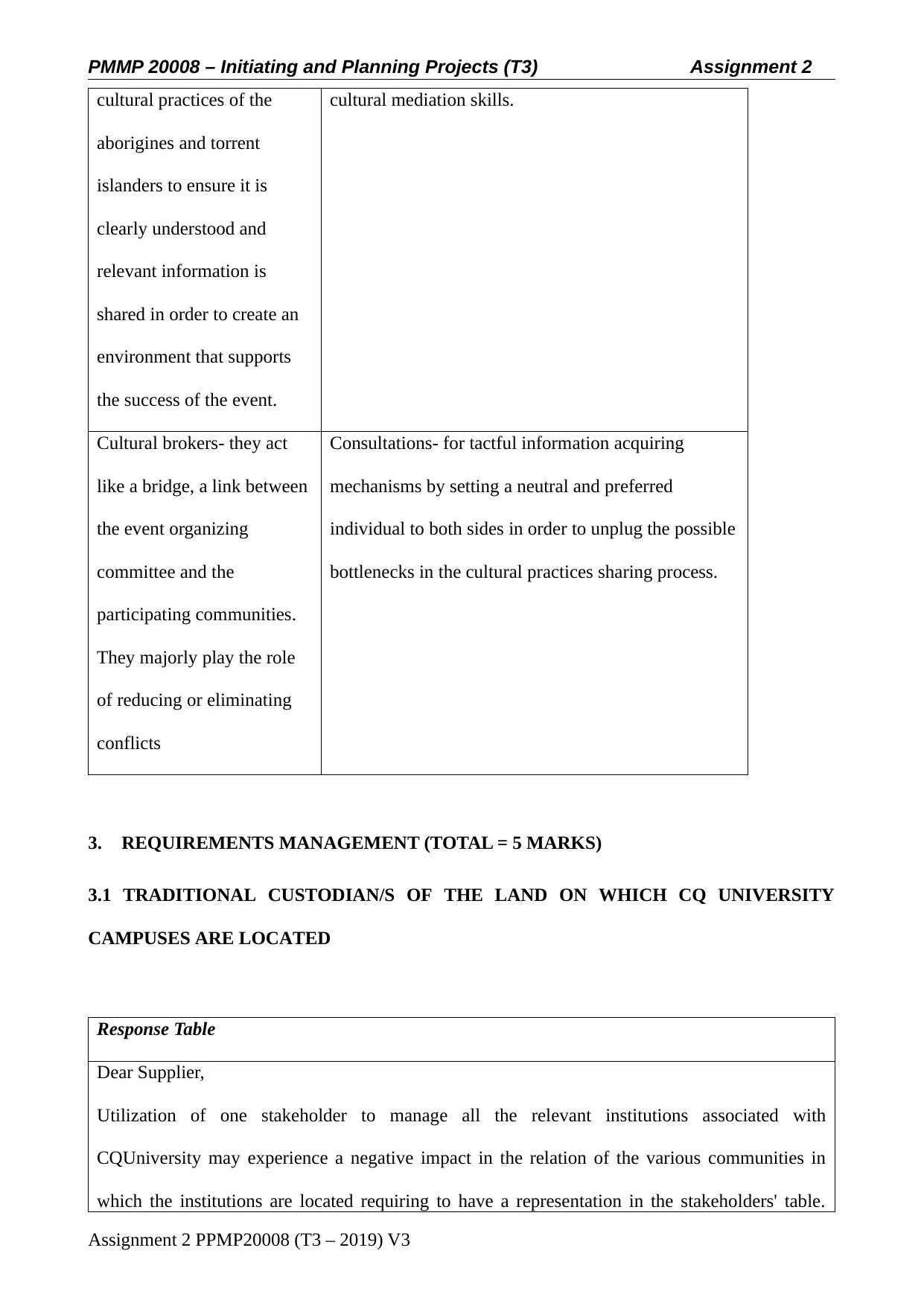
PMMP 20008 – Initiating and Planning Projects (T3) Assignment 2
cultural practices of the
aborigines and torrent
islanders to ensure it is
clearly understood and
relevant information is
shared in order to create an
environment that supports
the success of the event.
cultural mediation skills.
Cultural brokers- they act
like a bridge, a link between
the event organizing
committee and the
participating communities.
They majorly play the role
of reducing or eliminating
conflicts
Consultations- for tactful information acquiring
mechanisms by setting a neutral and preferred
individual to both sides in order to unplug the possible
bottlenecks in the cultural practices sharing process.
3. REQUIREMENTS MANAGEMENT (TOTAL = 5 MARKS)
3.1 TRADITIONAL CUSTODIAN/S OF THE LAND ON WHICH CQ UNIVERSITY
CAMPUSES ARE LOCATED
Response Table
Dear Supplier,
Utilization of one stakeholder to manage all the relevant institutions associated with
CQUniversity may experience a negative impact in the relation of the various communities in
which the institutions are located requiring to have a representation in the stakeholders' table.
Assignment 2 PPMP20008 (T3 – 2019) V3
cultural practices of the
aborigines and torrent
islanders to ensure it is
clearly understood and
relevant information is
shared in order to create an
environment that supports
the success of the event.
cultural mediation skills.
Cultural brokers- they act
like a bridge, a link between
the event organizing
committee and the
participating communities.
They majorly play the role
of reducing or eliminating
conflicts
Consultations- for tactful information acquiring
mechanisms by setting a neutral and preferred
individual to both sides in order to unplug the possible
bottlenecks in the cultural practices sharing process.
3. REQUIREMENTS MANAGEMENT (TOTAL = 5 MARKS)
3.1 TRADITIONAL CUSTODIAN/S OF THE LAND ON WHICH CQ UNIVERSITY
CAMPUSES ARE LOCATED
Response Table
Dear Supplier,
Utilization of one stakeholder to manage all the relevant institutions associated with
CQUniversity may experience a negative impact in the relation of the various communities in
which the institutions are located requiring to have a representation in the stakeholders' table.
Assignment 2 PPMP20008 (T3 – 2019) V3
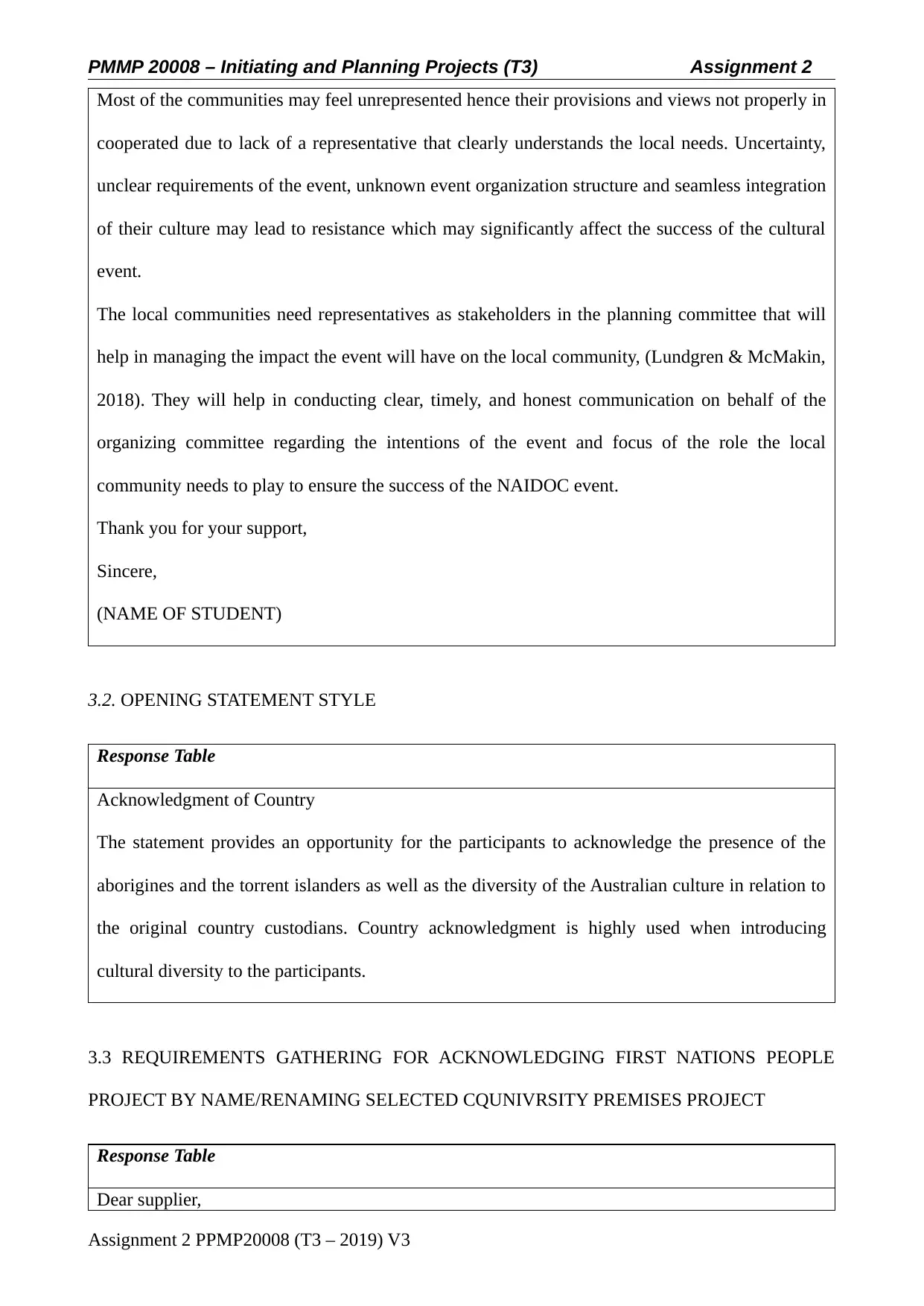
PMMP 20008 – Initiating and Planning Projects (T3) Assignment 2
Most of the communities may feel unrepresented hence their provisions and views not properly in
cooperated due to lack of a representative that clearly understands the local needs. Uncertainty,
unclear requirements of the event, unknown event organization structure and seamless integration
of their culture may lead to resistance which may significantly affect the success of the cultural
event.
The local communities need representatives as stakeholders in the planning committee that will
help in managing the impact the event will have on the local community, (Lundgren & McMakin,
2018). They will help in conducting clear, timely, and honest communication on behalf of the
organizing committee regarding the intentions of the event and focus of the role the local
community needs to play to ensure the success of the NAIDOC event.
Thank you for your support,
Sincere,
(NAME OF STUDENT)
3.2. OPENING STATEMENT STYLE
Response Table
Acknowledgment of Country
The statement provides an opportunity for the participants to acknowledge the presence of the
aborigines and the torrent islanders as well as the diversity of the Australian culture in relation to
the original country custodians. Country acknowledgment is highly used when introducing
cultural diversity to the participants.
3.3 REQUIREMENTS GATHERING FOR ACKNOWLEDGING FIRST NATIONS PEOPLE
PROJECT BY NAME/RENAMING SELECTED CQUNIVRSITY PREMISES PROJECT
Response Table
Dear supplier,
Assignment 2 PPMP20008 (T3 – 2019) V3
Most of the communities may feel unrepresented hence their provisions and views not properly in
cooperated due to lack of a representative that clearly understands the local needs. Uncertainty,
unclear requirements of the event, unknown event organization structure and seamless integration
of their culture may lead to resistance which may significantly affect the success of the cultural
event.
The local communities need representatives as stakeholders in the planning committee that will
help in managing the impact the event will have on the local community, (Lundgren & McMakin,
2018). They will help in conducting clear, timely, and honest communication on behalf of the
organizing committee regarding the intentions of the event and focus of the role the local
community needs to play to ensure the success of the NAIDOC event.
Thank you for your support,
Sincere,
(NAME OF STUDENT)
3.2. OPENING STATEMENT STYLE
Response Table
Acknowledgment of Country
The statement provides an opportunity for the participants to acknowledge the presence of the
aborigines and the torrent islanders as well as the diversity of the Australian culture in relation to
the original country custodians. Country acknowledgment is highly used when introducing
cultural diversity to the participants.
3.3 REQUIREMENTS GATHERING FOR ACKNOWLEDGING FIRST NATIONS PEOPLE
PROJECT BY NAME/RENAMING SELECTED CQUNIVRSITY PREMISES PROJECT
Response Table
Dear supplier,
Assignment 2 PPMP20008 (T3 – 2019) V3
⊘ This is a preview!⊘
Do you want full access?
Subscribe today to unlock all pages.

Trusted by 1+ million students worldwide
1 out of 29
Related Documents
Your All-in-One AI-Powered Toolkit for Academic Success.
+13062052269
info@desklib.com
Available 24*7 on WhatsApp / Email
![[object Object]](/_next/static/media/star-bottom.7253800d.svg)
Unlock your academic potential
Copyright © 2020–2025 A2Z Services. All Rights Reserved. Developed and managed by ZUCOL.





